Why Root Celery is Good, How to Grow and Use It Properly
Root celery is a biennial plant from the Celery family, or Umbrella. He comes from the Mediterranean countries. The inhabitants of Ancient Greece and Egypt used it in folk medicine. The first mention of celery as a food product appeared at the beginning of the 17th century. The culture is popular in European countries and relatively recently appeared in the diet of the inhabitants of Russia.
In this article, we have prepared detailed information on the cultivation of root celery in the open field and its areas of application.
The content of the article
What does root celery look like and grow?
In the first year, a large rounded or flat-round root crop is formed, weighing 400-600 g, with a diameter of 5-12 cm. Skin color is gray-white, flesh is white, creamy.
Three-lobed celery leaves... The length of the petioles is about 50 cm. The growing season of the plant is 180-200 days.
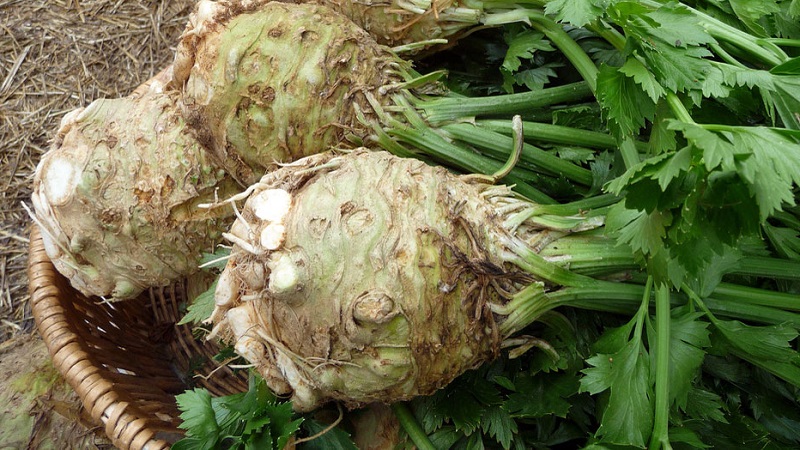
Pictured above is root celery.
In the second year, an arrow appears with a flower umbrella up to 1 m long... The seeds are small, gray-brown in color, characterized by a long germination period - about 30 days. After germination of seeds, sprouts appear in 15-20 days.
The peel of root vegetables is thin, easily peeled off... It is recommended to use gloves when processing - the juice stains the skin dark.
Root celery is added to broths, soups, salads, baked, stewed, fried, pickled and even make sweet jam from it.
Features of culture
Root celery seeds lose their germination quickly - shelf life does not exceed two years. The long growing season involves the use of the seedling method of plant cultivation.
Sowing work begins no later than February, so that the roots have time to ripen before the first frost.
Why Root Celery is Good
Root celery has a rich chemical composition and low calorie content, which allows it to be included in the diet.
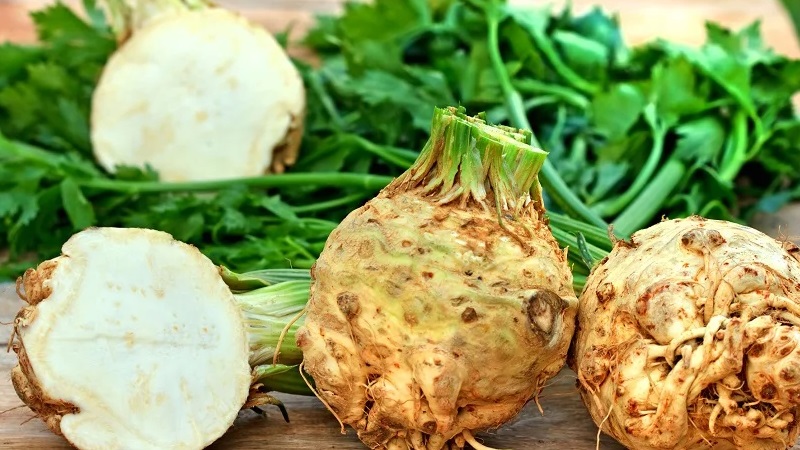
Composition and nutritional value
In the table - the vitamin and mineral composition of celery root (per 100 g).
| Name | Content | Norm |
| Vitamin A | 3 μg | 900 mcg |
| Beta carotene | 0.01 mg | 5 mg |
| Vitamin B1 | 0.03 mg | 1.5 mg |
| Vitamin B2 | 0.06 mg | 1.8 mg |
| Vitamin B4 | 9 mg | 500 mg |
| Vitamin B5 | 0,4 mg | 5 mg |
| Vitamin B6 | 0.15 mg | 2 mg |
| Vitamin B9 | 7 μg | 400 mcg |
| Vitamin C | 8 mg | 90 mg |
| Vitamin E | 0.5 mg | 15 mg |
| Vitamin H | 0.1 μg | 50 mcg |
| Vitamin K | 41 μg | 120 mcg |
| Vitamin PP | 1.2 mg | 20 mg |
| Potassium | 393 mg | 2500 mg |
| Calcium | 63 mg | 1000 mg |
| Silicon | 29 mg | 30 mg |
| Magnesium | 33 mg | 400 mg |
| Sodium | 77 mg | 1300 mg |
| Sulfur | 15 mg | 1000 mg |
| Phosphorus | 27 mg | 800 mg |
| Chlorine | 13 mg | 2300 mg |
| Iron | 0.5 mg | 18 mg |
| Iodine | 0.4 μg | 150 mcg |
| Cobalt | 1.8 μg | 10 mcg |
| Manganese | 0.158 mg | 2 mg |
| Copper | 70 mcg | 1000 mcg |
| Molybdenum | 4 μg | 70 mcg |
| Selenium | 0.7 μg | 55 mcg |
| Fluorine | 4 μg | 4000 mcg |
| Chromium | 2.4 μg | 50 mcg |
| Zinc | 0.33 mg | 12 mg |
Nutritional value of the product per 100 g:
- calorie content - 42 kcal;
- proteins - 1.5 g;
- fats - 0.3 g;
- carbohydrates - 7.4 g;
- fiber - 1.8 g;
- water - 88 g.
Benefit and harm
Benefits of Root Celery:
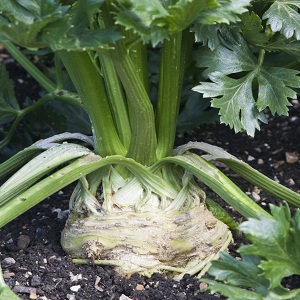 eliminates inflammatory processes;
eliminates inflammatory processes;- removes toxins;
- supports the immune system;
- regulates the work of the gastrointestinal tract;
- enhances sex drive;
- strengthens the walls of blood vessels;
- normalizes blood pressure;
- reduces the level of bad cholesterol;
- increases hemoglobin;
- eliminates allergies;
- improves intestinal peristalsis;
- tones up the body;
- reduces swelling;
- improves brain activity;
- regulates metabolism;
- rejuvenates the body;
- regulates the menstrual cycle.
Celery root undesirable for pregnant and lactating women, people suffering from varicose veins, stomach ulcers and duodenal ulcers.
Agrotechnics of culture
Root celery is grown through seedlings from seeds followed by picking and transfer to open ground... Care provides for sufficient watering, loosening, top dressing and side root trimming.
Seed and soil preparation
Sowing dates for celery seedlings depend on the growing region: in the northern regions - at the end of January - early February, in the central - all February, in the southern - the second decade of February - the first decade of March.
Seeds are stratified before sowing: incubated for 24 hours in warm water, wrapped in a damp cloth and left for 6-7 days at room temperature. Next, the cloth with seeds is placed in the refrigerator for 14-15 days.
In addition to stratification, use:
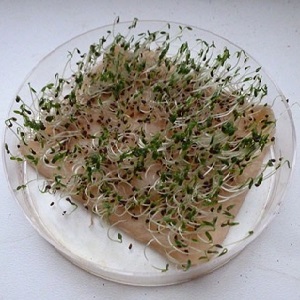 soaking in warm water for a week;
soaking in warm water for a week;- germination in wet gauze on a saucer with water (7-10 days);
- soaking in hot water;
- germination in wet sawdust.
The easiest way to prepare celery seeds for sowing - treatment with growth stimulants "Epin" or "Zircon".
Seeds purchased from trusted manufacturers do not need disinfection. Collected by hand are etched in a solution of potassium permanganate or "Fitosporin".
Sowing and caring for seedlings
A 2 cm layer of straw is placed at the bottom of the seedling boxes to maintain the optimum temperature of the root system and absorb excess water.
The soil mixture is prepared from peat, turf, humus, coarse river sand (3: 1: 1: 1). Add 400 g of ash and 1 tsp to a bucket of 10 kg. urea.
Sprouted seeds are slightly dried, mixed with sand and sown in boxes with moist soil. Sow in rows to a depth of 1 cm with an interval of 5 cm.
Place the container in a dark, warm place and cover glass or plastic wrap. The prepared seed material sprouts in 12-15 days at an air temperature of + 22 ... + 25 ° С.
After the sprouts appear, the film or glass is removed, and the box is placed on a lighted windowsill. The optimum air temperature is not higher than + 16 ° С.
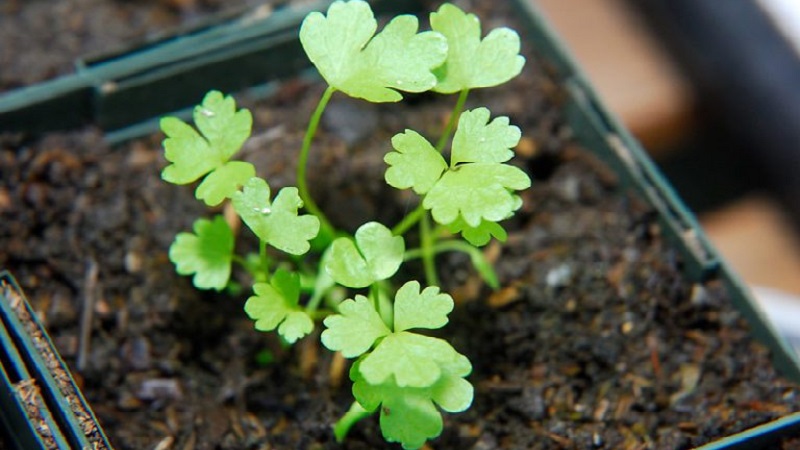
For the prevention of fungal diseases "Fitosporin" or "Trichodermin" is mixed into the water during irrigation. Watering frequency is 2-3 times a week.
Dense shoots thin out to prevent weakening of seedlings and stretching to growth. The procedure is repeated as needed.
Substrate periodically loosened with a wooden peg for additional aeration of the root system.
Root celery grows slowly for the first month... About 25 days after sowing, the first true leaves appear. At this stage, the seedlings are planted in individual containers with a volume of 300 ml. The thickness of the soil mixture is at least 10 cm.
When transferring, the seedlings are immersed in the soil until the cotyledon leaveswithout falling asleep at the central point of growth. The root system is carefully sprinkled with earth. The pick provides the growth of additional lateral roots, the seedlings take root better and develop in spacious containers.
When picking root celery seedlings you cannot pinch the main root, otherwise a brush of unsightly-looking roots with a small root crop will form.
Next, the seedlings are watered and shaded with paper for 3 days.... Pale leaves indicate a lack of minerals, so urea is used for feeding (1 tsp per 10 liters of water).
Celery seedlings grow best at temperatures air during the day + 15 ... + 16 ° С and + 11 ... + 12 ° С at night.
Important! If the air temperature at night stays at + 10 ° C for a long time, after transplanting into the garden, the plants throw out peduncles. At the same time, the quality and quantity of the crop decreases sharply.
Further care of the seedlings includes loosening the soil, watering 2-3 times in 7 days, airing and periodic fertilizing with mineral compositions: 1 tsp. "Nitrofoski" for 1 liter of warm water. It is even better to use Kemira-Lux and Solvent complex dressings. Each time after dressing, the leaves are sprayed with a spray bottle to rinse out the remaining nutrients and prevent burns.
1-2 weeks before planting seedlings in the garden, the containers are taken out into the open air... First, they leave only during the day, and then at night. This must be done to harden the plants and better survival in a new place. 3 hours before transplanting, the seedlings are watered abundantly.
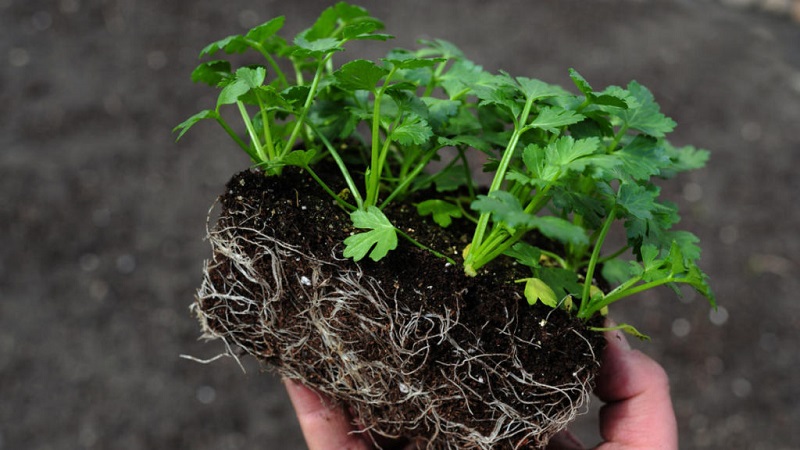
Landing in open ground
Celery outdoors planted at the age of 50-60 days, after the appearance of 4-5 true leaves... Large root crops should not be expected from weak and overexposed seedlings.
The optimal transfer period for root celery seedlings is the second decade of May. In the southern regions, it is planted 1-2 weeks earlier.
Early celery yields higher yields than with celery of late varieties.
Root celery grown on light sandy loam soil rich in humus... The plot is chosen from the south side of the garden.
In autumn, the earth is dug up and fed with humus (10 liters per 1 m²). In the spring, deep plowing is carried out and the soil is watered with a strong solution of potassium permanganate or copper sulfate. On the site, holes are formed with a depth of 10 cm.The planting scheme is 20 × 20 cm.Row spacing is 50 cm.
It can be useful:
Care
Care rules:
- The soil is kept constantly moist, without overflowing and avoiding excessive dryness. Watering frequency depends on the weather.
- The plot is mulched with sawdust, straw or rotted hay to prevent weed growth and retain moisture.
- Loosening is carried out after each watering, weeding - as the weeds grow.
- As soon as the root crop increases in size, the soil is raked off, freeing the root part and stripping the side roots. This contributes to the formation of rounded and large root crops.
- The culture is fed with an infusion of chicken manure (1:15) 2 weeks after planting in the ground, "Nitrofoskoy" or "Superphosphate" (25 g per 10 l of water) - at the end of July.
- Root celery tops are not cut until harvest, otherwise the root crop will not receive proper nutrition and will ripen small.
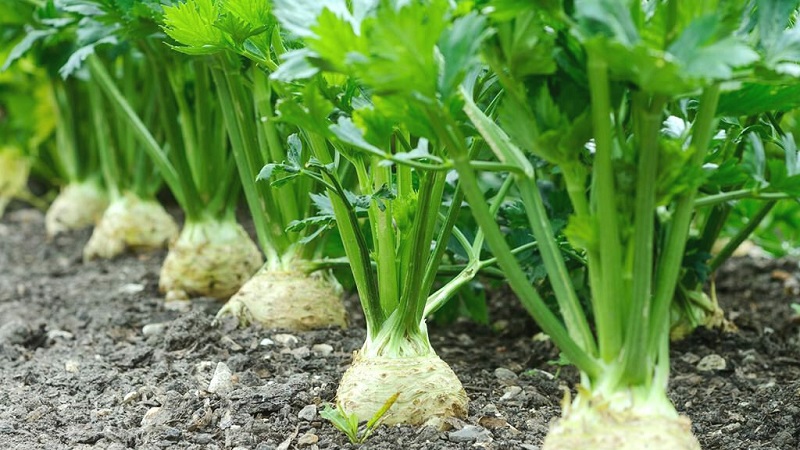
Diseases and pests
Root celery is resistant to most fungal and viral diseases: viral mosaic, white rot, black leg. To prevent infection, it is enough to regularly weed the beds, maintain an optimal level of soil moisture, observe crop rotation, and feed with minerals in a timely manner.
No chemicals are used to kill slugs and carrot fliesas root crops and foliage absorb toxic substances like a sponge. Biological preparations are used to process plantings: "Bitoxibacillin", "Gaupsin", "Boverin", "Fitoverm", "Lepidocid", "Verticillin".
Slugs are collected by hand or sprayed with a solution of ammonia (2 tbsp. L. Per 10 liters). All procedures are carried out at night when pests are activated.
To scare away carrot flies, use:
- ammonia (2 tbsp. l. per 10 l);
- saline solution (1 tbsp. l. per 10 l);
- onion peel (400 g per 5 l);
- orange zest (5 kg per 5 l);
- tobacco dust, red ground pepper, mustard powder (for dusting plants).
Harvesting and storage
Yellow and sluggish foliage indicates full ripeness of root crops... The day before digging, the soil is watered abundantly for easy extraction of the celery. From loose and soft soil, root crops are pulled by the tops.
It is difficult to get celery out of the clogged land, so gardeners use a shovel or pitchfork. Root vegetables are carefully pryed and pulled, the greens are cut, the soil is peeled off, the vegetables are left to dry in the garden.
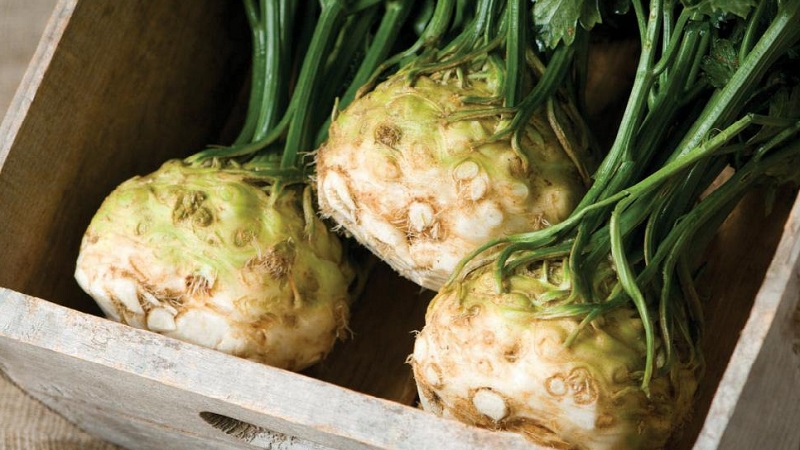
The injured eat first, they are not suitable for storage, because they quickly deteriorate.
Roots stored in a cool place at a temperature of + 2 ... + 8 ° C.
Application
Root celery apply in cooking, traditional medicine, include diets for weight loss.
In cooking
The product goes well with fruits, vegetables, meat and cereals... Grated root is marinated in soy sauce, seasoned with sour cream, vegetable oil and yogurt. For the winter, the root crop is dried and frozen.
Celery makes delicious vitamin jam without a strong smell. To prepare an unusual delicacy, you will need such products:
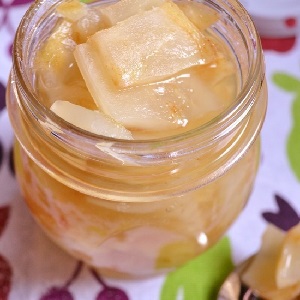 root celery - 1 kg;
root celery - 1 kg;- lemon - 2 pcs.;
- granulated sugar - 1 kg;
- water - 1.5 l;
- rock salt - 5 g.
Step by step cooking:
- Wash the root vegetable and remove the skin. Cut into thin slices.
- Boil the lemons until the peel is soft and grind in a blender until puree.
- Pour water into a saucepan and add sugar. Put on a low heat and bring to a boil.
- Place celery and lemon puree in syrup.
- Let it boil and cook over low heat for 30 minutes. The jam is done when the pieces are clear and the syrup thickens.
- At the end of cooking add salt, stir and remove from the stove.
- Put the mass in clean jars and roll up.
In folk medicine
Root celery prepare remedies for the treatment of diseases of the digestive and genitourinary systems, liver, pancreas.
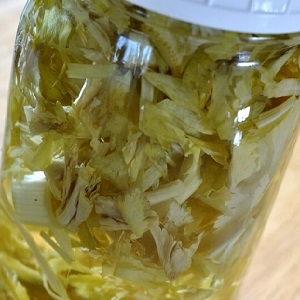 For an infusion for allergies and insomnia, the root is rubbed on a fine grater, poured with water (2 tablespoons of raw materials per 200 ml of water) and infused for 3-4 hours.
For an infusion for allergies and insomnia, the root is rubbed on a fine grater, poured with water (2 tablespoons of raw materials per 200 ml of water) and infused for 3-4 hours.
You can use vodka or alcohol instead of water. Such a remedy is used to rub sore spots with rheumatism and gout.
For gastritis and stomach ulcers, use a decoction: 20 g of grated root is boiled for 7 minutes in 250 ml of boiling water, then insisted for 10-12 hours in a thermos. The remedy is taken half an hour before meals, 2 tbsp. l. 3 times a day.
To increase potency, use freshly squeezed juice 1-2 tsp. 2 times a day 30 minutes before meals.
Slimming
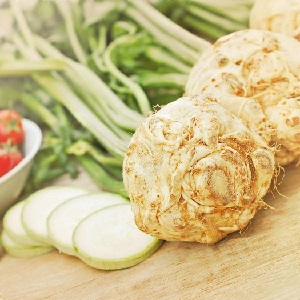 Celery root is popular in American and European weight loss systems... The product has a negative calorie content, that is, the body spends more energy on its digestion than it receives.
Celery root is popular in American and European weight loss systems... The product has a negative calorie content, that is, the body spends more energy on its digestion than it receives.
The root vegetable contains a large amount of fiber, which improves peristalsis, has a diuretic effect, and regulates metabolism.
Celery for weight loss can be eaten raw, baked and stewed... Freshly squeezed juice is drunk in 100 ml 2 times a day. To improve the taste, add apple, pumpkin, carrot, beetroot, orange juices. Salads are seasoned with low-fat yogurt, lemon juice and olive oil.
Reference. Celery root juice contains ideal proportions of potassium and sodium, which helps to effectively remove excess fluid from the body.
Conclusion
Despite the exactingness of root celery to care, subject to agrotechnical techniques, it is possible to grow and harvest a large crop. Planting work begins with the preparation of seeds and growing seedlings. Seedlings are provided with optimal daylight hours, sufficient watering and feeding with minerals and organics.
After planting in the garden, the plants are watered abundantly, weeds are removed, fed with chicken droppings and Superphosphate. To form rounded root crops, the lateral roots are cut.